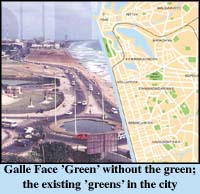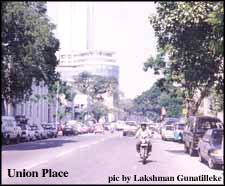
6th February 2000
Front Page|
News/Comment|
Editorial/Opinion| Business|
Sports|
Sports Plus| Mirror Magazine

![]()
- Dreaming green
- Or developing sans vision?
- New life rolls out from old mountain tale - Book review
- When that music breathed and sighed
- Kala Korner By Dee Cee
- Sinhala and Sinhale - A taste of Sinhala - 6
- Learning a thing or two about charity - West meets East
- So fast, so far
- Discuss, debate and then deliver
- The Vague Poetess
- Under 'the fool-wood' tree - A view from the hills
- Tale of caution from Irish 'peace' - Thoughts from London
- That mysterious Rolls-Royce
- Safe haven
- Letters to the editor








The UDA's recently gazetted zoning plan for Colombo envisages badly needed 'green' areas, but land acquisition remains a thorny issue
Dreaming green
By Tharuka Dissanaike
A greener Colombo? Wonderful, but when?
 Various
plans have been afoot to increase Colombo's green spaces, parks, playgrounds
and 'lung' areas. But many have not seen the light of day. Even projects
that get off the ground rarely see satisfactory completion. Case in point:
The Galle Face 'Green'. Despite a project that continued for over five
years, growing grass on the esplanade was never completed. Now Galle Face
flaunts its new earthwork, steps, paved walkways and amenities, but there's
still no green.
Various
plans have been afoot to increase Colombo's green spaces, parks, playgrounds
and 'lung' areas. But many have not seen the light of day. Even projects
that get off the ground rarely see satisfactory completion. Case in point:
The Galle Face 'Green'. Despite a project that continued for over five
years, growing grass on the esplanade was never completed. Now Galle Face
flaunts its new earthwork, steps, paved walkways and amenities, but there's
still no green.
The Urban Development Authority, in their recently gazetted zoning plan for Colombo specifies the need for many more green areas in the city. And we need it too. City populations are starved of recreation. Except for those who can pay the substantial membership fees of sports clubs in the city, the majority of city dwellers is packed into high-rises and crowded streets without gardens. Children grow up playing in drains and chasing a ball down a street, youth have no playground for a game of football or cricket and adults have no quiet park to relax in.
The UDA's vision for the city is certainly a green one. They plan to use the city's existing features like the ocean front, the Beira and canal banks to create waterfront parks and green belts. More playgrounds are planned in areas that have a high population density- on land that will be freed through the sustainable townships' programme which aims to resettle shanty colonies in high-rise flats. Marshes and flood retention lands in Mattakkuliya, Nawala, Battaramulla, Dehiwala and Kotte will be protected and preserved.
The UDA's greening efforts are not confined to the city of Colombo. The agency has already drawn plans for many large, fast developing townships. In the Dehiwala- Mount Lavinia municipal area, lands ear-marked for park and playground development will soon be gazetted preventing any development activity. Plans for Bandarawela, Gampola, Nuwara Eliya and Tangalle are pending approval from local authorities. Plans for Galle and Kandy are in the pipeline.
"Getting the local government's approval for these plans is the most difficult process," a senior official of the UDA said. "Often the ideal green zoning for the city will not agree with the local council's plans."
Another difficulty the UDA will have to face is the question of acquisition of private land for developing this network of parks and playgrounds in every city.
The UDA has set a minimum standard of 1.45 hectares of public recreational space for every 100 people. In both Colombo and Dehiwala-Mt. Lavinia the present ratio is far from this minimum. In many developed countries, especially European cities, the ratio is as high as five hectares per 1000 people.
"In Dehiwala-Mt. Lavinia for example, we want to create 44 hectares of new parks to supplement the existing 20 odd hectares of playground- but for a 230,000 population that is far from ideal," the UDA official said. "We hope to compensate by developing part of the Attidiya marsh as a nature park."
To rationalise their plan and the need for land to create new parks, the UDA has devised a method that defines, by distance to residences, the location of each park and playground that will be created. The idea is to create different levels of parks and playgrounds, which can cater to different segments of the populace.
Pocket Parks, for instance, will be small -half acre or so- plots that provide play areas for toddlers, the elderly or for general relaxation for those living in congested city streets without garden space. Mini Parks -2.5 acres- will provide a children's play area, jogging, walking and exercising space for adults, rest garden, snacks and restaurant facilities for a neighbourhood. It should not take more than three minutes on foot to reach the Mini Park.
Little larger Local Parks -up to 7.5 acres- could have a small cricket/football pitch, a small wooded area, running track etc and be accessible by not more than five minutes on foot.
The Community Park is the next level. This would be 15 acres or so, a large area to service an entire local district with good sports facilities, children's play area, ornamental park, restaurant and athletic facilities. This should be on a good bus route or not more than ten minutes walking distance from homes.
Several higher levels of playground, stadiums and full-sized sports complexes are also planned.
On paper all this looks very good. But what of implementation?
Even optimists at the UDA foresee difficulties in acquiring the land they have earmarked for greens and parks. Many a national level project has been scuttled by the reluctance of the affected population to accept state compensation for their loss of property. The long delayed Marine Drive is stalled after its first couple of kilometres due to resistance from residents refusing to move from their homes.
"Certainly land acquisition is going to be a major issue," the UDA spokesman said. "Mainly because we are trying to implement these green areas in already congested built-up cities. In Colombo and Dehiwala- Mt. Lavinia we have identified and demarcated the lands so that future development will not be allowed."
Also the UDA's master plan for park development could clash with development projects implemented by various other agencies- for instance, a large area of the Attidiya marsh, which the UDA planned for park development is claimed by the Ratmalana Airport for expansion of its runway.
The UDA also hopes to rope in the private sector in their bid to develop parks and playgrounds. Although essentially the parks and playgrounds will be public, the private sector will be allowed to have their stake in a restaurant, snack bar or speciality sports facilities etc, that could be incorporated into the parks system. "We need private sector investment coming into the plan. There is no practical way that the government alone could fund the entire acquisition and setting up of these green areas."
Or developing sans vision?
By Kumudini Hettiarachchi
What is the vision for Colombo? Is it to be a garden city, like in a rural area, or is it to be a very modern city like Singapore or Hong Kong without any distinct Sri Lankan characteristics?
Many are the fears that Colombo is being developed without a vision, "like embarking on a voyage without determining what the final destination would be". And these fears are expressed by the President of the Sri Lanka Institute of Architects (SLIA), Vidura Sri Nammuni who feels very strongly that the people who should be involved in the process of creating a garden city of Colombo, but at the same time making it a 21st century city have not been consulted.
Yes, the architects are up in arms, because they feel that planners have taken over their job. Detailing the roles played by the different groups, he said, draftsmen draw plans, architects design the buildings and engineers design the structure and make sure that the buildings don't fall down.
The Colombo Metropolitan Regional Structure Plan (CMRSP) has been finalised without consulting the SLIA which has been set up under an Act of Parliament, to step into situations like this when major changes are to be wrought to our environment. "We have opposed certain changes and now the plan is being amended, but only on an ad hoc basis," he said.
"What is the vision for our capital city?" he reiterated. "We would like to have a garden city but at the same time it must be the hub of commerce. It must be a modern city. This is where architects can step in and bring together two conflicting factors."
The SLIA has recommended that ideas for such a vision should be thrown open to architects in a competition. The most suitable and plausible "design" could then be selected and may be adapted to bring about the vision. The only requirement is prize money.
"The UDA, the Colombo Municipal Council, the Western Provincial Council and the SLIA, all of us who are involved in the development of the city should get-together," Mr. Nammuni stressed.
Picking more examples he asked, "How should we develop the seafront from Wellawatte to Kollupitiya? The setting is beautiful and the view of the sea should not be obstructed by buildings. But the reality is that, that stretch comprises real estate worth millions. Once again, there is a conflict and we could design multi-storey buildings which do not obstruct the view or prevent people from enjoying the breeze.
 "Another
area is Union Place, which has a particular character coming down the years.
But at the same time it needs tidying up, planning. If builders are allowed
to do whatever they want, such as putting up high-rises, Union Place will
lose its character. But look at the Hayleys office complex. Geoffrey Bawa
has designed low buildings, with that type of roof, in keeping with the
environment typical of Union Place. The modern features are there, while
retaining those special qualities of that particular area."
"Another
area is Union Place, which has a particular character coming down the years.
But at the same time it needs tidying up, planning. If builders are allowed
to do whatever they want, such as putting up high-rises, Union Place will
lose its character. But look at the Hayleys office complex. Geoffrey Bawa
has designed low buildings, with that type of roof, in keeping with the
environment typical of Union Place. The modern features are there, while
retaining those special qualities of that particular area."
 If
all streets and all cities look alike, man will not be able to relate to
his surroundings. As in nature, there must be variety, for only variety
gives sensory stimulation to man. If the artificial and built-up areas
are dull and uniform, humans will die. "You and I resemble our fathers
without dressing up like them. That's what we need. To capture the essence
of the past and transport that into the 21st century," according to
Mr. Nammuni.
If
all streets and all cities look alike, man will not be able to relate to
his surroundings. As in nature, there must be variety, for only variety
gives sensory stimulation to man. If the artificial and built-up areas
are dull and uniform, humans will die. "You and I resemble our fathers
without dressing up like them. That's what we need. To capture the essence
of the past and transport that into the 21st century," according to
Mr. Nammuni.
Colombo is being re-modelled with mega parks and mega buildings. But 50% of the population is poor and have to "crawl" into their homes. Then such a modern city will be mocking them and it would be natural for them to react with vandalism, he argues.
"The city should not only cater to people with money. Multi-storey buildings are good for high-income groups. But low-income earners have always lived in clusters, interacting with each other continuously.
"If you put them one above the other in little boxes, they can't interact and such programmes don't work. It has been tried out in several countries including Chile, but failed. The result would be that they would sell off their places and move out. Now we are taking 20,000 families, without a thought for sociological and political repercussions, and attempting to make a millennium township called Sahasipura. Why don't we make use of research done in places like India and make Colombo a home for both the affluent and the not so affluent?" he asks.
![]()
Front Page| News/Comment| Editorial/Opinion| Plus| Business| Sports| Sports Plus| Mirror Magazine
Please send your comments and suggestions on this web site to

